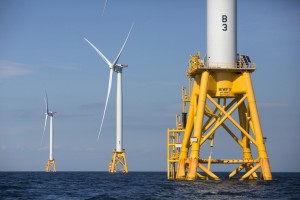Essay by Christine Todd Whitman and Leon Panetta, POLITICO, January 28, 2022
When world leaders gathered last fall at COP26, it was billed as the “world’s last best chance” to save the planet from the climate crisis. The conference ended with real uncertainty as to whether comprehensive action will be taken, here and abroad, to avoid catastrophe. Fortunately, one of the best opportunities for progress is all around us: the waves, wind and water along the U.S.’s nearly 100,000 miles of coastline.
As the engine of our planet’s weather and climate systems, the ocean’s potential as a climate solution is as vast as the ocean itself. In fact, ocean-based climate action can provide 20 percent of the emissions reductions needed to achieve global targets to limit climate change and its effects. According to the High Level Panel for a Sustainable Ocean Economy, “reductions of this magnitude are equivalent to the annual emissions from all coal-fired power plants worldwide or taking 2.5 billion cars off the road.”
Here are some key opportunities:
>>> Boost Offshore Renewables: Offshore renewables, like wind and wave energy, can help power the nation while cutting emissions. These sources of clean energy can serve as part of a just and equitable transition by providing economic benefits and abundant electricity to the communities that have suffered the most under climate change.
>>> Reduce Emissions from Shipping: We also need to look to the ocean to significantly reduce contributors of greenhouse gas emissions, such as maritime shipping, which generates more emissions than airlines. The administration, working with ports and the shipping industry, can implement strategies that will move us to zero-carbon shipping by 2050 to drastically reduce the climate contributions of cargo ships and freighters at sea. Infrastructure improvements at ports, fleet upgrades and alternative fuels can all be part of the effort.
>>> Rebuild Coastal Ecosystems: By protecting the ocean, we also enable the ocean to protect us through natural climate mitigation. Carbon-rich coastal environments like salt marshes, seagrass meadows and mangrove forests all naturally absorb carbon up to four times more effectively than trees on land. And when we conserve these habitats for their climate benefits, we are also protecting natural coastal infrastructure that will safeguard communities against storms and rising sea levels. This is particularly crucial for supporting marginalized communities, including low-income neighborhoods that were built in flood zones and are on the front lines of the climate crisis.
Washington has never before had a comprehensive ocean climate plan that weaves these efforts together. In order to realize the ocean’s potential to curb the climate crisis, the White House must marshal agencies across the government, so they are working in concert toward the same goals. President Joe Biden has taken a series of promising steps throughout his first year in office, but the U.S. still needs a coordinated federal strategy to turn this momentum into lasting results. The White House, to its credit, recently held itsfirst meeting of the congressionally authorized Ocean Policy Committee and made a commitment to develop a new cross-cutting strategy.
As the committee puts pen to paper, it should not waste the opportunity to map out the best strategies that embrace the ocean as a climate solution. From our time as Cabinet officials in previous administrations, we’ve been in the trenches on policymaking and know it is critical to have an overarching strategy rather than letting each agency chart its own path. A coordinated policy approach is more effective because it allows the administration to identify big picture goals and eliminate duplicative efforts.
Today, we work with a bipartisan effort to catalyze action toward meaningful ocean policy reform called the Joint Ocean Commission Initiative. Alongside over 100 ocean policy leaders — ranging from outdoor recreation brands to professional surfing organizations — we stand ready to join with the administration to advance a comprehensive ocean climate action plan.
It’s true that political disagreement has delayed climate action for far too long. While we come from different parties, we’ve found common cause on ocean policy and see it as a particularly fruitful area of bipartisan cooperation.
After all, our ocean and coastlines are vital to our economic and national security. They are also the foundation for what we call the “Blue Economy,” which acknowledges the wealth of marine resources — from sustainable fishing to aquaculture to shipping to tourism — that must be balanced sustainably to support jobs and economic growth. With the Blue Economy expected to grow at twice the rate of the overall economy, it is hard to imagine a better return on investment than securing the health and future of our ocean.
Now more than ever, we need to be taking every opportunity to avoid climate catastrophe — and the clock is ticking. From Category 5 hurricanes on the East Coast, to wildfires out West, to devastating tornadoes in the Midwest, we’re seeing the effects of climate change every day. Our country is poised like never before to advance bold climate action, and a coordinated ocean climate action plan can help turn that tide.
The ocean makes up over 70 percent of our planet. We believe it can help save the planet itself.
NOTE ~ Christine Todd Whitman is the former governor of New Jersey, former EPA administrator under President George W. Bush, and serves as co-chair of the Joint Ocean Commission Initiative Leadership Council. ALSO, Leon Panetta served as the CIA director and defense secretary under President Barack Obama, as White House chief of staff under President Bill Clinton, and was a former co-chair of the Joint Ocean Commission Initiative Leadership Council.

